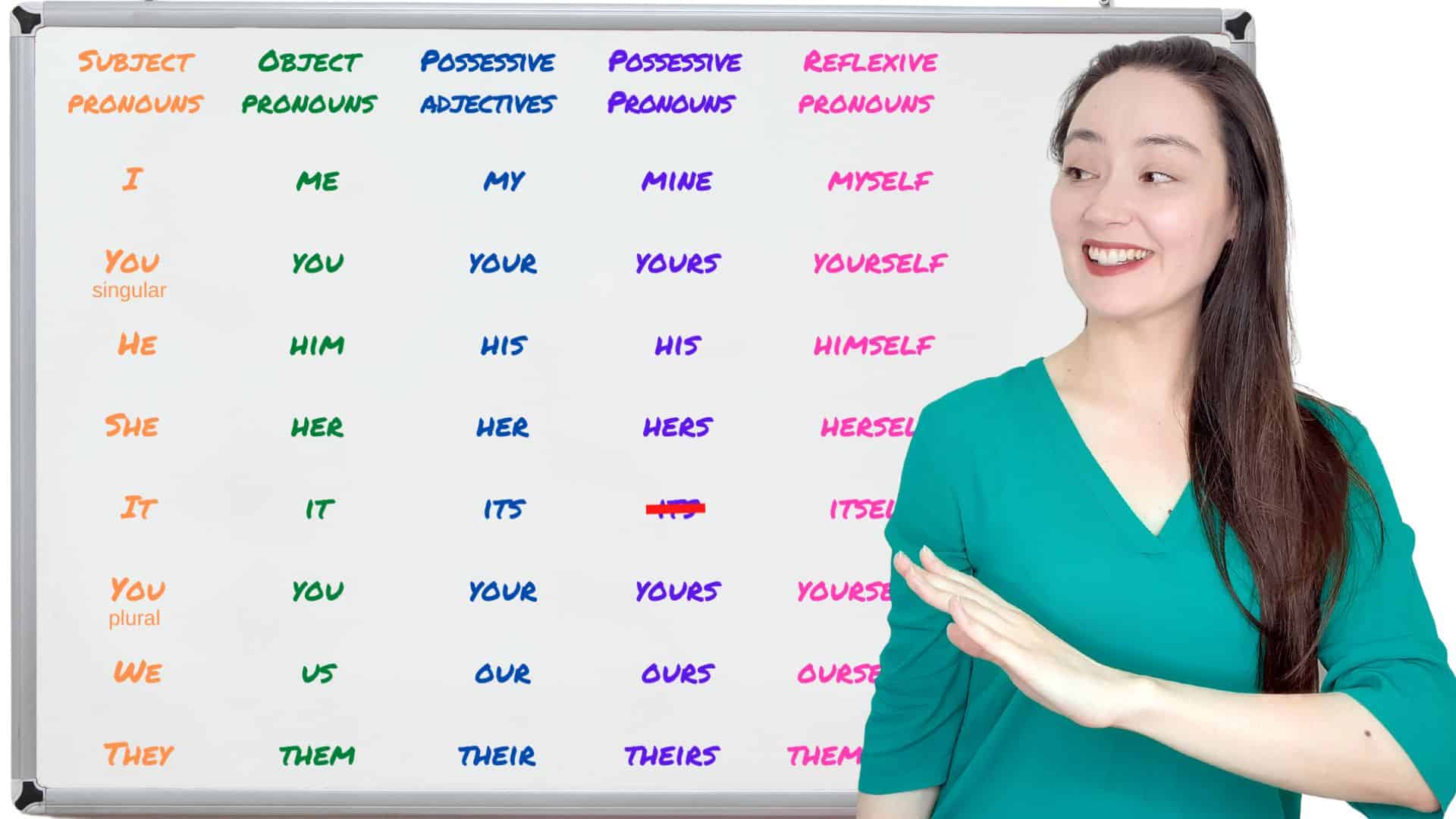ALL PERSONAL PRONOUNS: I, me, my, mine, myself….| subject pronouns | object pronouns | possessive adjectives | possessive pronouns | reflexive pronouns + VIDEO!
ALL PERSONAL PRONOUNS
You can learn about relative pronouns here: relative pronouns (who,which,that,whose,whom)
Subject pronouns
I sat on a bench.
You sat on a bench. (singular)
He sat on a bench
She sat on a bench.
It sat on a bench. (imagine “it” is a dog)
You sat on the bench. (plural)
We sat on a bench.
They sat on a bench.
(They can also be used for things, not just people. The tickets were expensive. THEY were expensive.)
Object pronouns
*If you “sketch” something, you make a simple drawing using a pen or pencil.
- Mo sketched me.
Mo sketched I. - Mo sketched you. (singular)
- Mo sketched him.
- Mo sketched her.
- Mo sketched it.
- Mo sketched you. (plural)
- Mo sketched us.
- Mo sketched them. We can use THEM for things.
Exception #1:
Normally, THEY and THEM are used as plural pronouns.
However, if we do not know if a person is a man or a woman (or we don’t care), they/them can be used.
A: Someone called you.
B: What did they want? (1 person)
A: I’m not sure. I told them to send you an email. (1 person)
Exception #2
Normally, IT would never be used for a person.
However, we often use IT to introduce someone informally.
On the phone:
A: Hello?
B: Hi, it’s me. (It is me.)
A: Who’s at the door?
B: It’s the pizza delivery guy. (It is the pizza delivery guy.)
We can also introduce a new baby’s gender this way:
It’s a boy!
It’s a girl!
If you’re enjoying this blog on all personal pronouns, please check out the link below to another popular topic!
Possessive adjectives
Your possessive adjective must have a noun.
- Box A has my signature.
- Box B has your signature.
- Box C has his signature.
- Box D has her signature.
I like her signature. Its letters are very clear.
Box E has our signatures. Notice the plural.
Box F has their signatures. Notice the plural.
DON’T CONFUSE its with it’s
*same pronunciation
Its letters are very clear.
possessive adjective + noun
It’s easy to read.
It is easy to read.
It’s been written in back ink.
It has been written in black ink.
Its and It’s are NOT the same.
Possessive pronouns
Possessive pronouns replace possessive adjectives.
- Possessive adjective: Teresa liked my logo design.
- Possessive pronoun: Teresa liked MINE
PA: Your idea was the best.
PP: YOURS was the best. With possessive pronouns, you can also begin a sentence.
PA: We need his password.
PP: We need HIS.
PA: That bag is her bag.
PP: That bag is HERS.
PA: Don’t touch its thorns.
PP: There is NO possessive pronoun form for “its”. Don’t touch its.
PA: A: Order #32! B: Oh, that’s our order.
PP: Oh that’s OURS.
PA: You can’t use their team name.
PP: You can’t use THEIRS.
When you use possessive pronouns, it needs to be clear what you are talking about.
You cannot walk into your office and say:
A: Where is mine?
B: Where is your…what?
A: Oh, my chair. Where is my chair?
NOUN (singular or plural) + OF + possessive pronoun
This structure is a common alternative to possessive adjectives.
Jamie is a friend of mine.
Clarissa is a classmate of his.
A friend of mine will be visiting me over the holidays.
They are students of ours.
So, what’s the difference?
Jamie is a friend of mine.
Jamie is my friend.
Clarissa is a classmate of his.
Clarissa is his classmate.
A friend of mine will be visiting me over the holidays.
My friend will be visiting me over the holidays.
Many times these can mean the same thing, but…
the “of” structure is more general. You are mentioning the person because he/she is ONE friend/relative/colleague out of a group.
Jamie is a friend of mine. = I have many friends, but Jamie is a (one) friend of mine.
Clarissa is a classmate of his. He has many classmates, but Clarissa is a (one) classmate of his.
You can really feel the difference in the next example:
Pete is a husband of mine.
Pete is my husband.
These are both grammatically correct, but only sentence 2 makes sense because I have 1 husband. The first sentence sounds odd because it seems like I have more than 1 husband.
Reflexive pronouns
If the subject and the object are the SAME person, you need to use a reflexive pronoun.
I accidentally gave myself a black eye when I was playing tennis. I accidentally gave me a black eye…
You should cook for yourself more often.
He told himself to relax before the interview.
She bought herself a birthday present.
This toilet closes itself.
You made yourselves look bad when you were late for the meeting.
We forgot the key and trapped ourselves in the basement.
They bought themselves new bikes.











